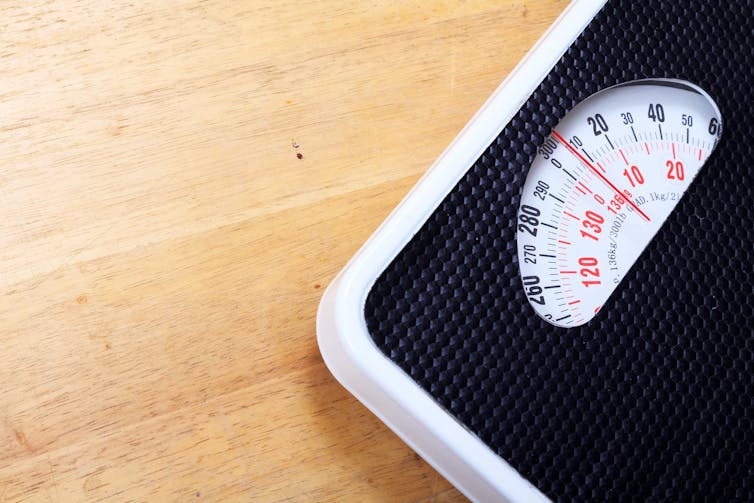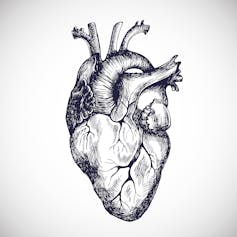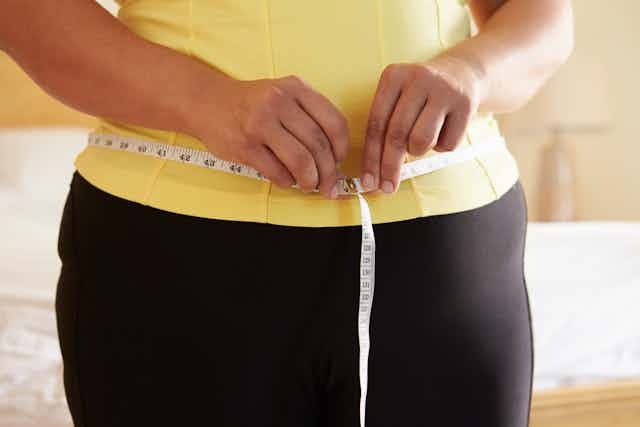Anyone who has tried to lose weight and keep it off knows how difficult the task can be. It seems like it should be simple: Just exercise to burn more calories and reduce your calorie intake. But many studies have shown that this simple strategy doesn’t work very well for the vast majority of people.
A dramatic example of the challenges of maintaining weight loss comes from a recent National Institutes of Health study. The researchers followed 14 contestants who had participated in the “World’s Biggest Loser” reality show. During the 30 weeks of the show, the contestants lost an average of over 125 pounds per person. But in the six years after the show, all but one gained back most of their lost weight, despite continuing to diet and exercise.
Why is it so hard to lose weight and keep it off? Weight loss often leads to declines in our resting metabolic rate – how many calories we burn at rest, which makes it hard to keep the weight off. So why does weight loss make resting metabolism go down, and is there a way to maintain a normal resting metabolic rate after weight loss? As someone who studies musculo-skeletal physiology, I will try to answer these questions.
Activating muscles deep in the leg that help keep blood and fluid moving through our bodies is essential to maintaining resting metabolic rate when we are sitting or standing quietly. The function of these muscles, called soleus muscles, is a major research focus for us in the Clinical Science and Engineering Research Center at Binghamton University. Commonly called “secondary hearts,” these muscles pump blood back to our heart, allowing us to maintain our normal rate of metabolic activity during sedentary activities.

Resting metabolism and weight maintenance
Resting metabolic rate (RMR) refers to all of the biochemical activity going on in your body when you are not physically active. It is this metabolic activity that keeps you alive and breathing, and very importantly, warm.
Quiet sitting at room temperature is the standard RMR reference point; this is referred to as one metabolic equivalent, or MET. A slow walk is about two MET, bicycling four MET, and jogging seven MET. While we need to move around a bit to complete the tasks of daily living, in modern life we tend not to move very much. Thus, for most people, 80 percent of the calories we expend each day are due to RMR.
When you lose weight, your RMR should fall a small amount, as you are losing some muscle tissue. But when most of the weight loss is fat, we would expect to see only a small drop in RMR, as fat is not metabolically very active. What is surprising is that relatively large drops in RMR are quite common among individuals who lose body fat through diet or exercise.
The “World’s Biggest Loser” contestants, for example, experienced a drop in their resting metabolic rate of almost 30 percent even though 80 percent of their weight loss was due to fat loss. A simple calculation shows that making up for such a large drop in RMR would require almost two hours a day of brisk walking, seven days a week, on top of a person’s normal daily activities. Most people cannot fit this activity level into their lifestyle.
There’s no question that eating a balanced diet and regular exercise are good for you, but from a weight management perspective, increasing your resting metabolic rate may be the more effective strategy for losing weight and maintaining that lost weight.
The connection between RMR and your heart
Metabolic activity is dependent on oxygen delivery to the tissues of the body. This occurs through blood flow. As a result, cardiac output is a primary determinant of metabolic activity.
The adult body contains about four to five liters of blood, and all of this blood should circulate throughout the body every minute or so. However, the amount of blood the heart can pump out with each beat is dependent on how much blood is returned to the heart between beats.

If the “plumbing” of our body, our veins in particular, was made of rigid pipes, and the skin of our legs was tough like that of bird legs, cardiac outflow would always equal cardiac inflow, but this is not the case. The veins in our body are are quite flexible and can expand many times their resting size, and our soft skin also allows lower body volume expansion.
As a result, when we are sitting quietly, blood and interstitial fluid (the fluid which surrounds all the cells in our body) pools in the lower parts of the body. This pooling significantly reduces the amount of fluid returning to the heart, and correspondingly, reduces how much fluid the heart can pump out during each contraction. This reduces cardiac output, which dictates a reduced RMR.
Our research has shown that for typical middle-aged women, cardiac output will drop about 20 percent when sitting quietly. For individuals who have recently lost weight, the fluid pooling situation can be greater because their skin is now much looser, providing much more space for fluids to pool. This is especially the case for people experiencing rapid weight loss, as their skin has not had time to contract.
Raising metabolic activity
For young, healthy individuals, this pooling of fluid when sitting is limited because specialized muscles in the calves of the legs – the soleus muscles – pump blood and interstitial fluid back up to heart. This is why soleus muscles are often referred to as our “secondary hearts.” However, our modern, sedentary lifestyles mean that our secondary hearts tend to weaken, which permits excessive fluid pooling into the lower body. This situation is now commonly referred to as “sitting disease.”

Moreover, excessive fluid pooling can create a vicious cycle. Fluid pooling reduces RMR, and reduced RMR means less body heat generation, which results in a further drop in body temperature; people with low RMR often have persistently cold hands and feet. As metabolic activity is strongly dependent on tissue temperature, RMR will therefore fall even more. Just a 1 degree Fahrenheit drop in body temperature can produce a 7 percent drop in RMR.
One logical, though expensive, approach to reduce fluid pooling after weight loss would be to undergo cosmetic surgery to remove excess skin to eliminate the fluid pooling space created by the weight loss. Indeed, a recent study has confirmed that people who had body contouring surgery after losing large amounts of weight due to gastric banding surgery had better long-term control of their body mass index than people who did not have body contouring surgery.
What can you do?
A much more convenient approach to maintaining RMR during and after weight loss is to train up your secondary hearts, or soleus muscles. The soleus muscles are deep postural muscles and so require training of long duration and low intensity.
Tai chi, for instance, is an effective approach to accomplish this. However, we’ve observed that many people find the exercises onerous.
Over the last several years, investigators in the Clinical Science and Engineering Research Lab at Binghamton University have worked to develop a more practical approach for retraining the soleus muscles. We have created a device, which is now commercially available through a university spin-off company, that uses a specific mechanical vibration to activate receptors on the sole of the foot, which in turn makes the soleus muscles undergo a reflex contraction.
In a study of 54 women between the ages of 18 and 65 years, we found that 24 had secondary heart insufficiency leading to excessive fluid pooling in the legs, and for those women, soleus muscle stimulation led to a reversal of this fluid pooling. The ability to prevent or reverse fluid pooling, allowing individuals to maintain cardiac output, should, in theory, help these individuals maintain RMR while performing sedentary activities.
This premise has been confirmed, in part, by recent studies undertaken by our spin-off venture. These unpublished studies show that by reversing fluid pooling, cardiac output can be raised back to normal levels. Study results also indicate that by raising cardiac output back to normal resting levels, RMR returns to normal levels while individuals are sitting quietly. While these data are preliminary, a larger clinical trial is currently underway.

